Chapter Two
Dangerous Concept, Dangerous Times: Galileo, Kepler and the Church
Page 3As more recent science has shown, both Galileo and his opponents were partly right and partly wrong. Galileo was right in asserting the mobility of the earth and wrong in asserting the immobility of the sun. His opponents were right in asserting the mobility of the sun and wrong in asserting the immobility of the earth. — Catholic Answers, "The Galileo Controversy" (San Diego: Catholic Answers, 2004)
Introduction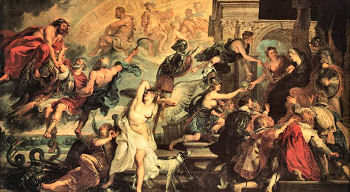 They were the writers, poets, painters, inventors and great thinkers of their time. Men like William Shakespeare, Guy Fawkes, Frances Bacon, René Descartes, Milton and Rembrandt. In science, there was Wilhelm Schickard, the German Polymath who built one of the first calculating machines, Tycho Brahe, who was making precise observations of the stars and planets at Hven and
They were the writers, poets, painters, inventors and great thinkers of their time. Men like William Shakespeare, Guy Fawkes, Frances Bacon, René Descartes, Milton and Rembrandt. In science, there was Wilhelm Schickard, the German Polymath who built one of the first calculating machines, Tycho Brahe, who was making precise observations of the stars and planets at Hven and 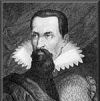 Galileo the Florentine, who was using his newly created telescope to view the moon and beyond. It was a time when Elizabeth I was Queen of England and the hopes of Protestants soared while those of the great Spanish Armada sank. War and the Holy Inquisition were racing across the environs of Europe rooting out enemy and heretic alike, real or imagined. It was into this age that the great German astronomer Johannes Kepler (right) was born. Image above: Apotheosis of Henry IV and the Proclamation of the Regency of Marie de Medici 1622-24, courtesy the Musee du Louvre, Paris
Galileo the Florentine, who was using his newly created telescope to view the moon and beyond. It was a time when Elizabeth I was Queen of England and the hopes of Protestants soared while those of the great Spanish Armada sank. War and the Holy Inquisition were racing across the environs of Europe rooting out enemy and heretic alike, real or imagined. It was into this age that the great German astronomer Johannes Kepler (right) was born. Image above: Apotheosis of Henry IV and the Proclamation of the Regency of Marie de Medici 1622-24, courtesy the Musee du Louvre, ParisKepler
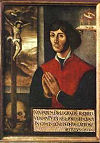 Johannes Kepler was a mathematician, astronomer and astrologer who developed the famous three laws of planetary motion; his first two laws were published in 1609 and his third law in 1618. Collectivelty, these three laws of planetary motion have today become one of the several most notable and lasting legacy of 17th century science and astronomy.
Johannes Kepler was a mathematician, astronomer and astrologer who developed the famous three laws of planetary motion; his first two laws were published in 1609 and his third law in 1618. Collectivelty, these three laws of planetary motion have today become one of the several most notable and lasting legacy of 17th century science and astronomy.In 1609, while Galileo was just learning the details of the newly invented telescope, Kepler had progressed and expanded upon the theoretical and methodical research work of two prominent scientific thinkers: Polish astronomer and mathematician Nicolaus Copernicus (1473-1543) and the Prince of Astronomers, Tycho Brahe (1546-1601). Kepler's three laws were, in part, a result of Tycho Brahe's own life's work and took the form of very percise astornomical data on a large group of stars—while an assistant for Tycho, he had been assigned the task of analyzing the data of planetary observations and in particular, that of the planet Mars—which Kepler had "liberated" upon the death of Brahe in 1601. His research culminated in the 1609 publication of a book entitled Astronomia nova or New Astronomy, and contained his first two laws of planetary motion. Kepler's Astronomia nova also modified Copernicus' own theories that had been published sixty years earlier under the title De revolutionibus orbium coelestium or On the Revolution of the Heavenly Spheres. At the heart of Copernicus' De revolutionibus was his own belief in a sun-centered or heliocentric solar system, a theory contrary to the accepted belief in a earth-centered universe or geocentric system, which had held sway since the days of Aristotle and Ptolemy and had become, by the 17th century, dogmatic teaching. Image above left is a Portrait of Nicholas Copernicus (1473—1543).
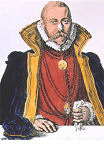 In addition, Kepler made other lasting contributions within various other areas of science and astronomy that included a systematic study of a newly discovered star (this was actually a supernova, today known as SN 1604), which he published in a work entitled De Stella Nova; research work conducted in optical theory and an analysis on the working of the human eye, published in a 1604 manuscript entitled Astronomiae Pars Optica or The Optical Part of Astronomy, gaining recognition as the foundation of modern optics; described his theoretical, experimental investigations and improvements on the optical properties of telescopes which appeared in the 1611 Dioptrice and published Tycho Brahe's accurate data on the positions of stars and planets which were of immense value to navigators. Image at right, Tycho Brahe courtesy H. Heintzmann.
Kepler was also a man of the Bible and during his lifetime of study, he retained a firm and steady religious conviction that "God had created the world according to an intelligible plan that is accessible through the natural light of reason." To Kepler's thinking, the scientific world revolved around an errant train of thought which he attempted to set right through the use of his own theoretical concepts of the universe and its motion; his convictions would not only lead to his famous three laws, but would also cause him to suffer from the various religious persecutions that were prevalent during his lifetime. Still, Kepler never wavered in his belief that his life's work was the proof of God's design of the heavens, writing: [1]
In addition, Kepler made other lasting contributions within various other areas of science and astronomy that included a systematic study of a newly discovered star (this was actually a supernova, today known as SN 1604), which he published in a work entitled De Stella Nova; research work conducted in optical theory and an analysis on the working of the human eye, published in a 1604 manuscript entitled Astronomiae Pars Optica or The Optical Part of Astronomy, gaining recognition as the foundation of modern optics; described his theoretical, experimental investigations and improvements on the optical properties of telescopes which appeared in the 1611 Dioptrice and published Tycho Brahe's accurate data on the positions of stars and planets which were of immense value to navigators. Image at right, Tycho Brahe courtesy H. Heintzmann.
Kepler was also a man of the Bible and during his lifetime of study, he retained a firm and steady religious conviction that "God had created the world according to an intelligible plan that is accessible through the natural light of reason." To Kepler's thinking, the scientific world revolved around an errant train of thought which he attempted to set right through the use of his own theoretical concepts of the universe and its motion; his convictions would not only lead to his famous three laws, but would also cause him to suffer from the various religious persecutions that were prevalent during his lifetime. Still, Kepler never wavered in his belief that his life's work was the proof of God's design of the heavens, writing: [1]
"I had the intention of becoming a theologian ... but now I see how God is, by my endeavours, also glorified in astronomy, for 'the heavens declare the glory of God.' " [2]
December 27, 1571
In the interplay between quantitative observation and theoretical construction that characterizes the development of modern science, we have seen that Brahe was the master of the first but was deficient in the second. The next great development in the history of astronomy was the theoretical intuition of Johannes Kepler (1571-1630), a German who went to Prague to become Brahe's assistant — from Astrowiki's Astronomy 161 [3]
Johannes Kepler - The early years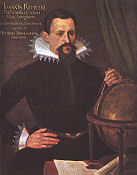 On December 27, 1571, in the town of Weil der Stadt, Swabia (Württemberg), a poor mercenary's wife gave birth to a son, the first of seven children (only three would live to maturity), whom they named Johannes Kepler and to which it appears as their sole historical contribution to the world with one notable exception. In her later years, Kepler's mother, Katharine, would be tried for witchcraft; Kepler would later choose neither words of praise or flattery in his description of either. As it was, Kepler's father, Heinrich, seems to have disappeared in the later part of 1580, presumably killed in the war then raging in the Netherlands, the Eighty Years' War, or from wounds sustained in a naval campaign in Italy. During his childhood, Kepler and his mother lived in his grandfather's inn where, he tells us in his biography, he used to help by serving patrons of the inn. Image left is from the Collegium Wilhelmitanum (Thomasstift), Strasbourg and is a contemporary oil painting of Kepler, the only picture from his later years and perhaps the only authentic portrait, which Kepler sent to Matthias Bernegger in 1619. [4]
On December 27, 1571, in the town of Weil der Stadt, Swabia (Württemberg), a poor mercenary's wife gave birth to a son, the first of seven children (only three would live to maturity), whom they named Johannes Kepler and to which it appears as their sole historical contribution to the world with one notable exception. In her later years, Kepler's mother, Katharine, would be tried for witchcraft; Kepler would later choose neither words of praise or flattery in his description of either. As it was, Kepler's father, Heinrich, seems to have disappeared in the later part of 1580, presumably killed in the war then raging in the Netherlands, the Eighty Years' War, or from wounds sustained in a naval campaign in Italy. During his childhood, Kepler and his mother lived in his grandfather's inn where, he tells us in his biography, he used to help by serving patrons of the inn. Image left is from the Collegium Wilhelmitanum (Thomasstift), Strasbourg and is a contemporary oil painting of Kepler, the only picture from his later years and perhaps the only authentic portrait, which Kepler sent to Matthias Bernegger in 1619. [4]-fn1
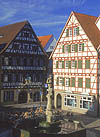 In spite of his poverty, Kepler's education followed the typical course for a young man of his region and this included local as well as seminary schooling. In 1576, he attended the Latin school in the city of Leonberg, having moved there with his parents and in 1584, he entered the Protestant seminary at Adelberg. But if Kepler's education was normal his health (and in this he was certainly not alone) was anything but. "As a seven-month child, Kepler was sickly from birth, he contracted smallpox. His vision was severely defective, and he had various other illnesses throughout childhood, some of which may have been hypochondria." Image at right is the historical market place in Leonberg where at Marktplatz 11 can be found the former residence of the Kepler family, courtesy Stuttgart Marketing GmbH [5]
In spite of his poverty, Kepler's education followed the typical course for a young man of his region and this included local as well as seminary schooling. In 1576, he attended the Latin school in the city of Leonberg, having moved there with his parents and in 1584, he entered the Protestant seminary at Adelberg. But if Kepler's education was normal his health (and in this he was certainly not alone) was anything but. "As a seven-month child, Kepler was sickly from birth, he contracted smallpox. His vision was severely defective, and he had various other illnesses throughout childhood, some of which may have been hypochondria." Image at right is the historical market place in Leonberg where at Marktplatz 11 can be found the former residence of the Kepler family, courtesy Stuttgart Marketing GmbH [5]
He took twice as long as normal children to get through elementary latin. He did a little better when he got to the higher school at Maulbronn, a school which only half a century earlier was haunted by the ill-famed Dr. Faustus - from Johannes Kepler: Life and Letters [6]
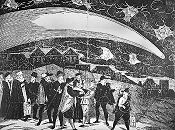 At a very early age, two notable and portentous events occurred that were to introduced the heavens and the objects that move within them to Kepler: the Great Comet of 1577 and the Lunar Eclipse of 1580. "Johann Kepler developed a love for astronomy at an early age. He observed the Great Comet of 1577 when he was six and the 1580 Lunar Eclipse, events that no doubt fueled his curiosity and enthusiasm for science." [7]
At a very early age, two notable and portentous events occurred that were to introduced the heavens and the objects that move within them to Kepler: the Great Comet of 1577 and the Lunar Eclipse of 1580. "Johann Kepler developed a love for astronomy at an early age. He observed the Great Comet of 1577 when he was six and the 1580 Lunar Eclipse, events that no doubt fueled his curiosity and enthusiasm for science." [7]"During his childhood his mother took him outside to view the great comet of 1577. She was interested in this apparition because it was believed that comets foretold dark events to come. Tycho Brahe observed this same comet form his observatory on the island of Hven. He concluded that it was farther away from the Earth than the Moon was. Michael Mastlin, at the University of Tubingen also observed this comet. Both of these men would later have a great influence on Kepler's life." Image above left is an engraving made by Jiri Daschitzky of the Great Comet of 1577 as seen over Prague on November 12 of that year. [8]
-fn2
In addition to this introduction of astronomical objects and events, Kepler also showed an early propensity towards religion, wishing for a life centered upon the religious order of his day. After two years at the Maulbronn monastery school, he still retained a strong aspiration to be a Lutheran pastor of a church, a desire that may have been reinforced as a result of his solitary nature; friendless, isolated and at times, withdrawn. Yet, we begin to see another side of Kepler emerge, if only slightly. In order to later earn admittance to the region's university in Württemberg, Kepler attended the monastery school ("Evangelische Seminar" or Protestant Seminary, the form in which this educational institution still exists today) where he studied Greek, Latin, music and geometry. He began to equate the last of these subjects to the "mind of God", thereby empowering himself with both math and religion and it was both these forces, from this point onwards, that would drive his scientific ambitions through the rest of his life. [9] Kepler, Mastlin and the University of Tubingen
...who had devoted himself passionately to the pursuit of deep insight into the nature of natural incidents, and who, despite all inner and outer difficulties also reached his high aim. — Albert Einstein in a pre-text of a book about Johannes Kepler from Short life history: Johannes Kepler.
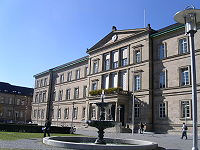 The University of Tübingen is located in the Baden-Württemberg region of Germany and is one of the oldest universities in the country, having been founded in 1477 by Count Eberhard V. It is internationally noted in medicine, natural sciences and the humanities and has been consistently ranked first amongst all German universities for many years. It was also the university that Johannes Kepler entered in the year 1589; the same that fellow German Wilhelm Schickard would also attend and graduate from. Schinckard was a polymath and desinger of an improved calculating machine based on the Napier's Bones or Rods model, and one of Kepler's younger contemporaries with whom he would later correspond with regarding the benefits and use of Schinckard's invention in calculating astronomical tables. Image above left is the University's Neue Aula courtesy Wikipedia.
The University of Tübingen is located in the Baden-Württemberg region of Germany and is one of the oldest universities in the country, having been founded in 1477 by Count Eberhard V. It is internationally noted in medicine, natural sciences and the humanities and has been consistently ranked first amongst all German universities for many years. It was also the university that Johannes Kepler entered in the year 1589; the same that fellow German Wilhelm Schickard would also attend and graduate from. Schinckard was a polymath and desinger of an improved calculating machine based on the Napier's Bones or Rods model, and one of Kepler's younger contemporaries with whom he would later correspond with regarding the benefits and use of Schinckard's invention in calculating astronomical tables. Image above left is the University's Neue Aula courtesy Wikipedia.Kepler's years at Maulbronn and Adelberg had not been his happiest nor his easiest; he had been afflicted by one disease or another throughout his attendance. Nor had he been well liked by his very competitive fellow students who saw him as a rather odd person whom, when not withdrawn and solitary, was often found involved in sharp, very outspoken arguments over religious matters. Yet, he had been well thought of by his instructors and tutors (a few who had themselves just graduated from the University of Tübingen) who recognized his growing talents:
Young Kepler worked hard at his studies and soon his tutors, many of them recent graduates of Tubingen, realized that he was a student of unusual ability. So rapid was his progress that two years later he was elevated to the higher convent school at nearby Maulbronn. It was in this town, just a few decades earlier, that the mysterious Dr. Faustus had lived the legendary hero of stories and poems in world literature. [10]
So it was, that in September of 1589, Kepler put behind his hard lean days and entered the University of Tübingen, where events over the next five years would change both his way of thinking and career. Tübingen Stift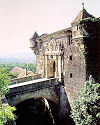 It was known as the Tübingen Stift or Tübingen Foundation and was founded for the children of "poor pious people, with an industrious and God-fearing character." Those attending the university's seminary were required to hear lecutres in the liberal arts for two years prior to their theological studies. Additional studies were in the fields of mathematics, physics and astronomy and were to later prove a boon for the young Kepler as they also provided instruction on the tools he would later use in his scientific work. Kepler worked hard and studiously, as he had done during his earlier education, displaying an ability that gained him a small scholarship that he had applied for in his second year. In 1591, Kepler took and passed his master's examination, again requesting a similar scholarship that was awarded in, what was now his third year, by the university's senate. Those approving his grant felt Kepler an exceptional student by writing "that something special may be expected from him". He was soon to prove them right. Image left is of the Castle Hohentübingen where the university's cultural and academic institutions were relocated. The renaissance portal (shown) was built around 1606 in the style of a Roman triumphal arch, whose center shows the emblem of the Duchy of Württemberg. [11]
It was known as the Tübingen Stift or Tübingen Foundation and was founded for the children of "poor pious people, with an industrious and God-fearing character." Those attending the university's seminary were required to hear lecutres in the liberal arts for two years prior to their theological studies. Additional studies were in the fields of mathematics, physics and astronomy and were to later prove a boon for the young Kepler as they also provided instruction on the tools he would later use in his scientific work. Kepler worked hard and studiously, as he had done during his earlier education, displaying an ability that gained him a small scholarship that he had applied for in his second year. In 1591, Kepler took and passed his master's examination, again requesting a similar scholarship that was awarded in, what was now his third year, by the university's senate. Those approving his grant felt Kepler an exceptional student by writing "that something special may be expected from him". He was soon to prove them right. Image left is of the Castle Hohentübingen where the university's cultural and academic institutions were relocated. The renaissance portal (shown) was built around 1606 in the style of a Roman triumphal arch, whose center shows the emblem of the Duchy of Württemberg. [11]Michael Maestlin
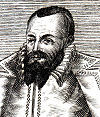 In the meantime, Kepler had the good fortune to study geometry and trigonometry under Michael Maestlin, the professor of mathematics at Tübingen and one of Europe's most highly regarded astronomers. For his part, Maestlin came to view Kepler as one of his most able of mathematical students, one that would go far and for Kepler, "far" would begin in 1594, but not before Michael Maestlin would arm Johannes Kepler with a concept that would turn into his life's work: the universe according to Polish churchman Nicolaus Copernicus. Image left of Michael Maestlin courtesy Scientific Identity: Portraits from the Dibner Library of the History of Science and Technology.
In the meantime, Kepler had the good fortune to study geometry and trigonometry under Michael Maestlin, the professor of mathematics at Tübingen and one of Europe's most highly regarded astronomers. For his part, Maestlin came to view Kepler as one of his most able of mathematical students, one that would go far and for Kepler, "far" would begin in 1594, but not before Michael Maestlin would arm Johannes Kepler with a concept that would turn into his life's work: the universe according to Polish churchman Nicolaus Copernicus. Image left of Michael Maestlin courtesy Scientific Identity: Portraits from the Dibner Library of the History of Science and Technology.
Footnotes
1. The date of his father's disappearance has been placed at vaious times: 1576, 1587 & 1589. Research indicates that he was still around in the mid 1580's, trying to make a living as a proprietor of a Tavern and left only after it's failure, disappearing entirely from the historical record at the close of the decade. See reference [10] below, Johannes Kepler And Planetary Motion p.7.
2. During the period from 1577-1580 there were numerous eclispes recorded by Tycho at Hven: two total lunar eclispes on April 2 & September 27 of 1577; one total lunar eclispe on September 16, 1578; a partial solar eclispe in February of 1579; one total lunar eclispe on January 31, 1580. He also followed and recorded the comet of Octorber 10, 1580.
Chapter Two
Dangerous Concept, Dangerous Times: Galileo, Kepler and the Church
Present & Future Historical Bytes











© Legal Copyright Notice:
Unless otherwise stated, all images, screen shots, electronic materials including instructional, software, scripts and web pages referred to herein or incorporated by reference are copyrighted © by A Universe in Time. None of the content herein may be reproduced or copied in any manner from this website without the prior written permission of above indicated copyright holder(s). All images and orginal works of the author(s) used within the above or foregoing web pages are for the sole purpose of information and display at A Universe in Time website and have been used with the kind permission of the respective owner(s).
BACK TO THE TOP